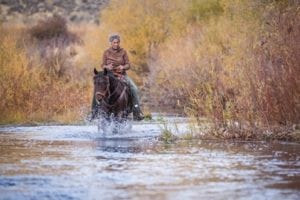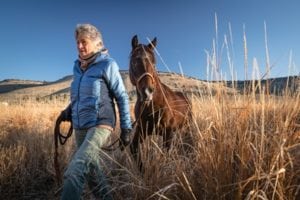Julie Weikel grew up in ‘ION’ country, the area where Idaho, Oregon and Nevada’s borders meet. She worked for over four decades in the area as a large animal vet, building an intimate, deep knowledge of the Owyhee’s people, history, land, water and wildlife. She’s traveled extensively throughout the Owyhee Canyonlands and explored many of it’s most remote places by horseback, truck and foot – adventures which continue to deepen and grow her tremendous knowledge of and love for this special part of Oregon.

The Owyhee began calling me from an early age. Growing up in the northern Nevada town of Winnemucca, a part of my heritage was an oft told tale about the bank robbery of Sept 1900 in which The Sundance Kid, with a couple of pals, made off with $32,640, not an insignificant sum in those days. But, for me, the intriguing part was how the posse pursuing them turned back when their trail left the Humboldt River and turned north into the Owyhee. What was this place that guaranteed escape? Forty five years of intermittent forays into that vast landscape has only served to broaden that question.
“The Owyhee” as I mean the phrase is not just the Oregon part but the entire Oregon/Idaho/Nevada drainage. It’s big country, some ten million acres of forbidding lands drained by a mystical system of desert gouges. It’s country that invites horseback scale investigation. My granddad said, “A horse is not worth having if it can’t trot from sunup to sundown.” I would add, “There’s no point in having such a horse if you don’t have a place where it can do that.” The Owyhee is just such a place.

And the Owyhee tests a horse even more than a rider. Lava tears up the toughest of hooves, and it takes a lot of “bottom” to face headwind hailstones and searing heat, usually both in the same day. I’ve been blessed with knowing a couple of horses with that kind of “bottom,” and we’ve shared parts of the Owyhee. Over a couple of three day stretches I rode from just south of Juntura, Oregon along the west side of the main Owyhee River canyon to the Nevada border. It’s a distance of well over a hundred miles as the crow flies, but I’ve no idea how many miles it takes to navigate the lava chasms that obstruct the paths down on the ground.
There’s plenty to see out there, hidden from those who fly by at 80 miles per hour. There are a lot of antelope, sneaky coyotes, grandiose birds of prey, and plenty of “tweeties” flitting around in the brush. Ah, the brush, the pungent assault. Sometimes more dust than aroma, but always discernible. There is no commercial perfume or seductive bloom that comes close to the powerful combination of horse sweat, sagebrush, and saddle leather. Feral horses sometimes provide a good horizon vista or a big cloud of dust. Occasionally, they will even approach and challenge. That’s good for an adrenaline rush and provides the opportunity to respect how competent these critters are in such a harsh environment, even if they are an invasive species.

Of course, there are lots of domestic cattle to watch. If one is so inclined, one can even choose to observe how they are using and changing the landscape, whether the rangeland standards and guidelines are being met, and speculate on the culture and values of a society that has deemed this a good use of this natural resource. There are occasional livestock carcasses, and, depending on the state of decay, one can speculate on just how the desert won that battle.
Always, when my gaze returns to the horizon, while the horse’s gait eats up the miles, my soul drinks long and deep. There are few places left for this kind of drinking, but, for now, the Owyhee is big enough.